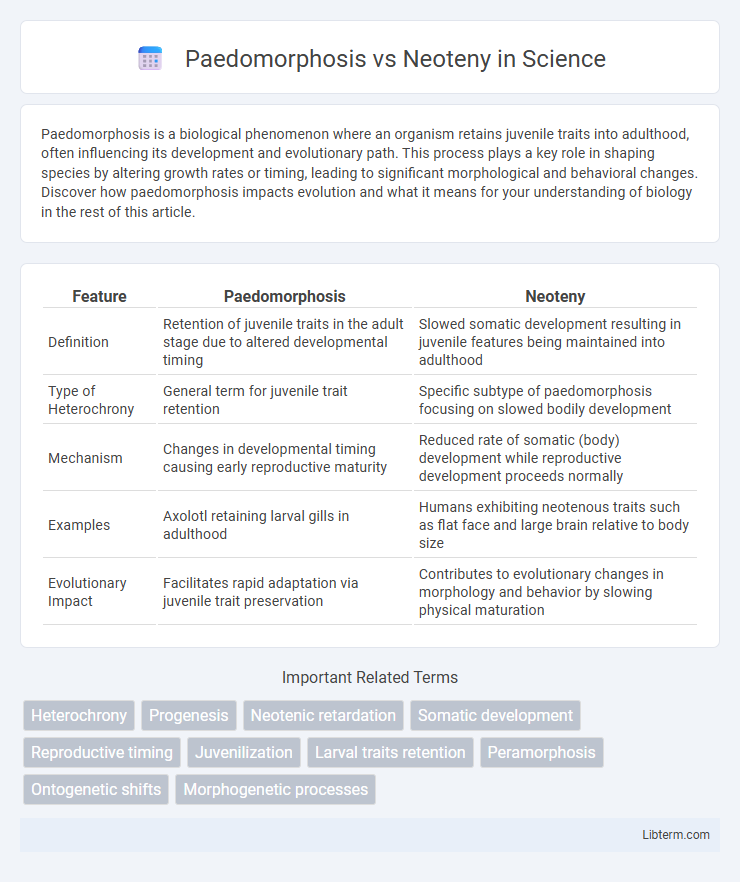Paedomorphosis is a biological phenomenon where an organism retains juvenile traits into adulthood, often influencing its development and evolutionary path. This process plays a key role in shaping species by altering growth rates or timing, leading to significant morphological and behavioral changes. Discover how paedomorphosis impacts evolution and what it means for your understanding of biology in the rest of this article.
Table of Comparison
| Feature | Paedomorphosis | Neoteny |
|---|---|---|
| Definition | Retention of juvenile traits in the adult stage due to altered developmental timing | Slowed somatic development resulting in juvenile features being maintained into adulthood |
| Type of Heterochrony | General term for juvenile trait retention | Specific subtype of paedomorphosis focusing on slowed bodily development |
| Mechanism | Changes in developmental timing causing early reproductive maturity | Reduced rate of somatic (body) development while reproductive development proceeds normally |
| Examples | Axolotl retaining larval gills in adulthood | Humans exhibiting neotenous traits such as flat face and large brain relative to body size |
| Evolutionary Impact | Facilitates rapid adaptation via juvenile trait preservation | Contributes to evolutionary changes in morphology and behavior by slowing physical maturation |
Understanding Paedomorphosis: Definition and Overview
Paedomorphosis refers to the retention of juvenile traits in the adult stage of an organism, resulting from changes in developmental timing. This evolutionary process alters the rate or timing of biological development, leading to adults that resemble the immature forms of their ancestors. Understanding paedomorphosis involves exploring its two main types: neoteny, where somatic development slows down, and progenesis, where reproductive development accelerates.
Neoteny Explained: A Closer Look
Neoteny, a form of paedomorphosis, occurs when the development of an organism slows down or delays, resulting in the retention of juvenile features into adulthood. This biological phenomenon is prominently observed in species such as axolotls and humans, where slower somatic development contrasts with faster sexual maturation. Understanding neoteny provides insights into evolutionary adaptations, developmental biology, and the genetic mechanisms influencing growth timing across species.
Key Differences Between Paedomorphosis and Neoteny
Paedomorphosis and neoteny both describe the retention of juvenile traits in adult organisms, but their key differences lie in developmental processes: paedomorphosis results from the overall slowing or truncation of development (including both somatic and reproductive traits), while neoteny specifically refers to the slowed somatic development with reproductive maturity reached at a normal rate. Paedomorphosis encompasses a broader category of developmental heterochrony, whereas neoteny is a subtype focused on the deceleration of morphological changes. Understanding these distinctions is critical in evolutionary biology for explaining how life history traits influence adult morphology across taxa.
Evolutionary Significance of Paedomorphosis
Paedomorphosis, the retention of juvenile traits into adulthood, plays a crucial evolutionary role by promoting morphological innovation and accelerating speciation through heterochronic shifts. This developmental process alters timing and rates of growth, enabling species to exploit new ecological niches and adapt rapidly to environmental changes. Compared to neoteny, which specifically involves slowed somatic development, paedomorphosis encompasses broader mechanisms impacting evolutionary trajectories and phenotypic diversity.
Biological Mechanisms Underlying Neoteny
Neoteny, a form of paedomorphosis, involves the retention of juvenile traits into adulthood due to slowed somatic development while reproductive capabilities proceed at a normal rate. This biological mechanism is driven by altered hormonal regulation, particularly delayed secretion of thyroid hormones and growth factors that modulate developmental timing. Genetic factors influencing these endocrine pathways result in extended growth periods, allowing neotenous traits to persist in mature organisms.
Examples of Paedomorphosis in the Animal Kingdom
Paedomorphosis is evident in animals like axolotls, which retain juvenile features such as gills and a larval body shape throughout their adult life, distinguishing them from related species that undergo full metamorphosis. The mudpuppy salamander also exhibits paedomorphosis, maintaining aquatic larval traits like external gills even as a sexually mature adult. Insects such as the mayfly demonstrate paedomorphosis by reaching reproductive maturity while retaining certain juvenile wing forms and body structures.
Notable Instances of Neoteny in Nature
Notable instances of neoteny in nature include the axolotl, which retains its larval gills and aquatic lifestyle throughout adulthood, exemplifying paedomorphic traits. Humans also exhibit neotenous features such as a relatively large brain, a flat face, and reduced body hair compared to other primates, contributing to extended learning periods. Certain domesticated dogs show neotenous traits like playful behavior and floppy ears, reflecting retained juvenile characteristics into adulthood.
Paedomorphosis vs Neoteny: Impacts on Development
Paedomorphosis and neoteny both involve the retention of juvenile traits into adulthood but differ in developmental mechanisms; paedomorphosis results from an overall slowing or truncation of development, whereas neoteny specifically reduces the rate of somatic development while reproductive maturation proceeds at a normal pace. These processes significantly impact morphological evolution and species adaptation by altering timing and expression of developmental genes such as Hox and Pax genes. Understanding their influence elucidates developmental plasticity and evolutionary pathways, especially in amphibians and certain mammals exhibiting pronounced juvenile characteristics in adult forms.
Genetic Factors Influencing Paedomorphosis and Neoteny
Genetic factors influencing paedomorphosis and neoteny involve regulatory genes that alter developmental timing, such as Hox genes and thyroid hormone receptors. Mutations or variations in these genes can delay or suppress metamorphosis, promoting retention of juvenile traits in adult organisms. Research on amphibians, especially axolotls, highlights the role of thyroid hormone pathway genes in governing neotenic development.
The Role of Environment in Shaping Paedomorphic and Neotenic Traits
Environmental factors significantly influence the development of paedomorphic and neotenic traits by altering growth rates and maturation timing in various species. In aquatic habitats with stable conditions, neoteny often arises as larvae retain juvenile features while achieving reproductive capability, exemplified by axolotls. Conversely, fluctuating environments may favor paedomorphosis by selecting for traits that delay somatic development, allowing organisms to adapt faster to ecological pressures without completing full metamorphosis.
Paedomorphosis Infographic

 libterm.com
libterm.com